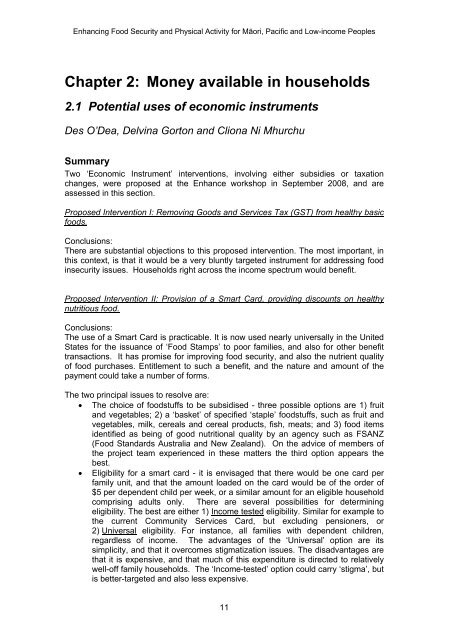enhancing food security and physical activity for maori, pacific and ...
enhancing food security and physical activity for maori, pacific and ...
enhancing food security and physical activity for maori, pacific and ...
- No tags were found...
Create successful ePaper yourself
Turn your PDF publications into a flip-book with our unique Google optimized e-Paper software.
Enhancing Food Security <strong>and</strong> Physical Activity <strong>for</strong> Māori, Pacific <strong>and</strong> Low-income PeoplesChapter 2: Money available in households2.1 Potential uses of economic instrumentsDes O’Dea, Delvina Gorton <strong>and</strong> Cliona Ni MhurchuSummaryTwo ‘Economic Instrument’ interventions, involving either subsidies or taxationchanges, were proposed at the Enhance workshop in September 2008, <strong>and</strong> areassessed in this section.Proposed Intervention I: Removing Goods <strong>and</strong> Services Tax (GST) from healthy basic<strong>food</strong>s.Conclusions:There are substantial objections to this proposed intervention. The most important, inthis context, is that it would be a very bluntly targeted instrument <strong>for</strong> addressing <strong>food</strong>in<strong>security</strong> issues. Households right across the income spectrum would benefit.Proposed Intervention II: Provision of a Smart Card, providing discounts on healthynutritious <strong>food</strong>.Conclusions:The use of a Smart Card is practicable. It is now used nearly universally in the UnitedStates <strong>for</strong> the issuance of ‘Food Stamps’ to poor families, <strong>and</strong> also <strong>for</strong> other benefittransactions. It has promise <strong>for</strong> improving <strong>food</strong> <strong>security</strong>, <strong>and</strong> also the nutrient qualityof <strong>food</strong> purchases. Entitlement to such a benefit, <strong>and</strong> the nature <strong>and</strong> amount of thepayment could take a number of <strong>for</strong>ms.The two principal issues to resolve are:• The choice of <strong>food</strong>stuffs to be subsidised - three possible options are 1) fruit<strong>and</strong> vegetables; 2) a ‘basket’ of specified ‘staple’ <strong>food</strong>stuffs, such as fruit <strong>and</strong>vegetables, milk, cereals <strong>and</strong> cereal products, fish, meats; <strong>and</strong> 3) <strong>food</strong> itemsidentified as being of good nutritional quality by an agency such as FSANZ(Food St<strong>and</strong>ards Australia <strong>and</strong> New Zeal<strong>and</strong>). On the advice of members ofthe project team experienced in these matters the third option appears thebest.• Eligibility <strong>for</strong> a smart card - it is envisaged that there would be one card perfamily unit, <strong>and</strong> that the amount loaded on the card would be of the order of$5 per dependent child per week, or a similar amount <strong>for</strong> an eligible householdcomprising adults only. There are several possibilities <strong>for</strong> determiningeligibility. The best are either 1) Income tested eligibility. Similar <strong>for</strong> example tothe current Community Services Card, but excluding pensioners, or2) Universal eligibility. For instance, all families with dependent children,regardless of income. The advantages of the ‘Universal’ option are itssimplicity, <strong>and</strong> that it overcomes stigmatization issues. The disadvantages arethat it is expensive, <strong>and</strong> that much of this expenditure is directed to relativelywell-off family households. The ‘Income-tested’ option could carry ‘stigma’, butis better-targeted <strong>and</strong> also less expensive.11
















